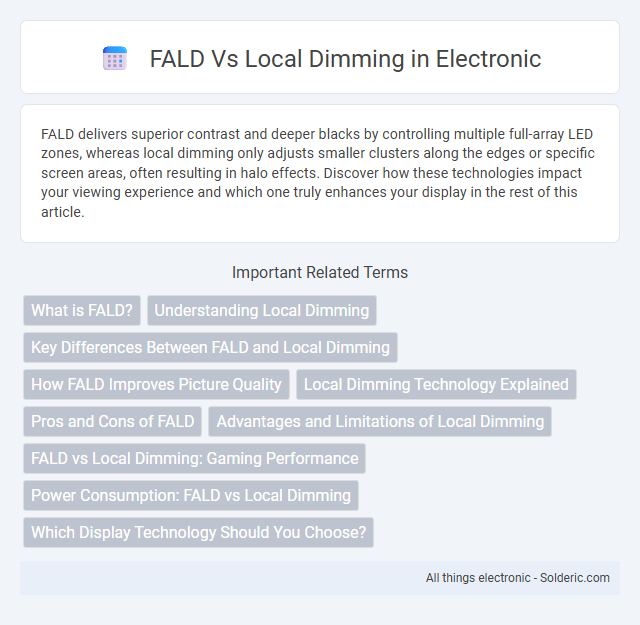FALD delivers superior contrast and deeper blacks by controlling multiple full-array LED zones, whereas local dimming only adjusts smaller clusters along the edges or specific screen areas, often resulting in halo effects. Discover how these technologies impact your viewing experience and which one truly enhances your display in the rest of this article.
Comparison Table
| Feature | Full Array Local Dimming (FALD) | Local Dimming (Edge or Zone) |
|---|---|---|
| Backlight Type | Full LED array behind the entire screen | LEDs placed only at screen edges or specific zones |
| Brightness Control | Individual dimming zones across full panel | Dimming limited to edges or large zones |
| Contrast Ratio | Higher contrast, deeper blacks | Lower contrast, potential halo effects |
| Picture Quality | Better uniformity and local detail | Less precise, can cause blooming |
| Cost | More expensive due to complex LEDs array | More affordable, simpler design |
| Energy Efficiency | Moderate, with precise power management | Generally more energy efficient |
| Use Case | High-end TVs, premium HDR content | Mid-range TVs, budget HDR options |
What is FALD?
Full Array Local Dimming (FALD) is a backlighting technology used in LED TVs where the entire screen is illuminated by an array of LEDs positioned directly behind the LCD panel. This setup allows precise control over specific zones, enhancing contrast by dimming or brightening individual areas independently. FALD delivers deeper blacks and improved picture quality compared to edge-lit local dimming systems.
Understanding Local Dimming
Local dimming enhances display contrast by selectively dimming the backlight in darker screen areas, improving black levels and overall picture quality. Full Array Local Dimming (FALD) uses an array of LEDs positioned directly behind the LCD panel, allowing more precise control compared to edge-lit local dimming systems. FALD's superior zone control reduces halo effects and increases contrast ratio, delivering a more immersive viewing experience with deeper blacks and brighter highlights.
Key Differences Between FALD and Local Dimming
Full Array Local Dimming (FALD) utilizes a grid of multiple independent LED zones behind the entire screen, allowing precise dimming control and better contrast compared to Local Dimming, which typically uses fewer edge-mounted zones. FALD enhances picture quality by reducing halo effects and improving black levels, whereas Local Dimming often results in less uniform brightness and contrast. You can expect FALD technology to deliver superior HDR performance and deeper blacks, making it ideal for high-end displays.
How FALD Improves Picture Quality
Full-Array Local Dimming (FALD) enhances picture quality by using an array of multiple LED zones behind the entire screen, enabling precise control of brightness and contrast. This technology significantly reduces blooming and improves black levels compared to edge-lit local dimming, resulting in deeper blacks and more vibrant colors. FALD's dynamic adjustments allow for better HDR performance, offering a more immersive and true-to-life visual experience.
Local Dimming Technology Explained
Local dimming technology enhances LED backlighting by dividing the panel into multiple zones that can dim or brighten independently, improving contrast and black levels compared to standard LED displays. FALD (Full-Array Local Dimming) uses an array of LEDs placed directly behind the entire screen, offering more precise control over brightness and deeper blacks than edge-lit local dimming systems. The increased number of dimming zones in FALD reduces halo effects and enhances HDR performance, making it superior for high-contrast and dark scene viewing.
Pros and Cons of FALD
Full-Array Local Dimming (FALD) enhances contrast and black levels by independently controlling LEDs across the entire screen, offering superior picture quality compared to edge-lit local dimming. FALD provides better uniformity and reduces halo effects, but it can be more expensive and thicker due to the complex LED backlight arrangement. Your viewing experience benefits from deeper blacks and improved HDR performance, though power consumption may be higher than simpler local dimming methods.
Advantages and Limitations of Local Dimming
Local dimming enhances contrast by independently adjusting the backlight in specific screen zones, resulting in deeper blacks and improved HDR performance. Its advantages include reduced halo effects and energy efficiency compared to Full Array Local Dimming (FALD), which uses more precise zone control but at higher cost and complexity. Limitations of local dimming include potential blooming artifacts around bright objects and less uniform black levels due to coarse dimming zones often found in edge-lit displays.
FALD vs Local Dimming: Gaming Performance
FALD (Full-Array Local Dimming) enhances gaming performance by providing deeper contrast and more precise backlight control compared to standard local dimming, resulting in improved shadow detail and reduced halo effects. Your gaming experience benefits from smoother visuals and better HDR performance, especially in dark scenes where accurate brightness zones prevent washout. Local dimming is effective for mid-range monitors but lacks the granular lighting zones that FALD offers, making FALD the preferred choice for high-level gaming immersion.
Power Consumption: FALD vs Local Dimming
FALD (Full Array Local Dimming) generally consumes more power than Local Dimming due to its use of multiple LED zones behind the entire screen to enhance contrast and black levels. Local Dimming, often limited to edge-lit LEDs, requires less energy as it controls fewer dimming zones. However, the increased power draw of FALD results in superior picture quality with deeper blacks and reduced halo effects.
Which Display Technology Should You Choose?
Full-Array Local Dimming (FALD) offers superior contrast and deeper blacks by independently controlling backlight zones across the entire screen, making it ideal for high-end home theater setups. Local Dimming, typically edge-lit with fewer dimming zones, provides decent contrast enhancement but may suffer from halo effects and less uniform brightness. Choosing between FALD and Local Dimming depends on your budget, viewing environment, and need for picture quality, with FALD being preferable for premium HDR performance.
FALD vs Local Dimming Infographic

 solderic.com
solderic.com